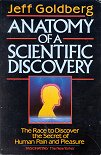In the autumn of 1973 in Aberdeen, a young man, John Hughes, and an old man, Hans Kosterlitz, began the most exciting adventure of their lives - one that would dramatically alter mankind's understanding of the brain and transform these men themselves from obscure scientists into world-famous celebrities.
Hughes and Kosterlitz were looking for a naturally occurring substance within the body that resembled drugs derived from the opium poppy - nothing less than a natural morphine that would unlock not just the secrets of physical pain and pleasure, but would open the way to understanding how the brain orchestrates the whole symphony of human emotions.
What began in the slaughterhouses of Aberdeen, and in the high-tech labs of Johns Hopkins and Stanford Universities, led to one of the most important scientific breakthroughs of the twentieth century. As in the classic In Search of the Double Helix, the story involves sacrifice, betrayal, intense competition and unexpected 'accidents'. The stakes were just as high, the potential rewards just as golden, the price of failure just as devastating.
[History of the discovery of endorphins]
